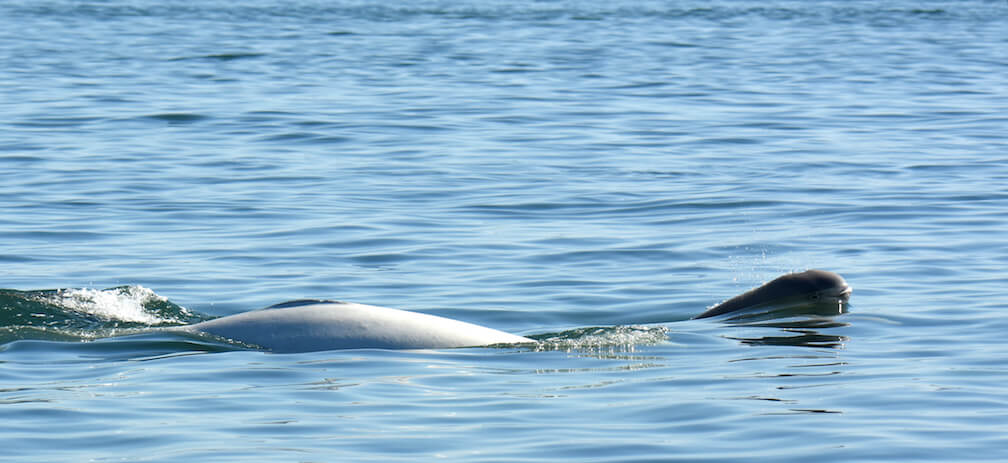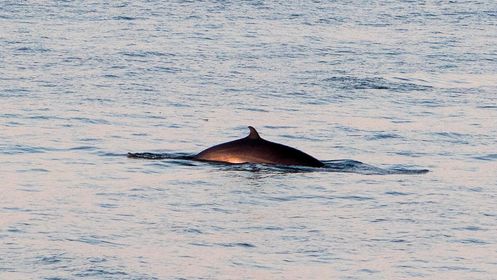Belugas took full advantage of their first day of calm in the Saguenay Fjord. Many light-coloured backs were present in the river’s blue waters on Tuesday, marking with great fanfare the start of the summer season and the closure of Baie Sainte-Marguerite to water traffic.
In fact, this week Baie Sainte-Marguerite was officially closed to boating and shipping. From June 21 to September 21, watercraft will be unable to enter the bay. A transit zone has also been established in front of the bay where mariners must circulate without stopping and at speeds of between 5 and 10 knots.
However, a record 45 individuals were counted in the afternoon of June 21. The same day the area was closed! “Perhaps to celebrate the closing of the bay to boaters?” suggests a cetacean enthusiast with a touch of humour. Most of the individuals that frequent this sector are adults accompanied by young, and this protective measure aims to reduce the level of disturbance they have to contend with. Baie Sainte-Marguerite is a place of great social importance for belugas.
In the St. Lawrence, belugas have also been seen near Les Bergeronnes. A little farther upstream, in Saint-Irénée, the appearance of a dozen or so white backs offers a superb backdrop for a local resident on her lunch break: “Yesterday around mid-day, we were enjoying a bite to eat when we saw a dozen or so belugas: some to the right, some to the left, but quite far apart. I may have also seen a mother with her calf.” On the opposite shore, a naturalist observed belugas in Cacouna earlier this week.
Big whales in the gulf
Observations of baleen whales have been rather sparse in the estuary, notwithstanding the presence of minke whales: one off Cap-à-L’Aigle in La Malbaie, another that returned several days in a row off Pointe Noire in Baie-Sainte-Catherine, and, lastly, an individual in Tadoussac Bay that approached the marina at low tide.
Another species, a humpback whale, was seen near Les Escoumins. Farther downstream, near Godbout, two visiting naturalists observed large blasts offshore on the morning of June 21. “Hard to tell whether it was a humpback or a fin whale. We’re not sure which species it was,” ponders one of them. From the ferry that connects Godbout and Matane, we observe what may be the same individuals. “That was really the highlight of my week: two humpback whales while setting out from Godbout. Everybody on board the boat saw them, huddling near the window to get a better look. It was most obvious: two big round spouts.
But the majority of large whales are being observed in the gulf. Indeed, a number of humpback, fin and minke whales are concentrated off the tip of Cap Bon-Ami in Gaspé. It’s a perfect site for whale-watchers. “We’ve been seeing breaching and lobtailing. We’ve also been treated to awesome seabird spectacles, which, combined with the whales, has been truly magnificent. All we can do is smile!” exclaims a naturalist and captain working in the area.
About 8 minke whales were observed near the end of the docks in the village of Grande-Vallée, while two belugas were seen swimming off the coast of Petite-Vallée. On the other side of the river, in the north shore community of Gallix, a resident observes two harbour seals, while at Sept-Îles it is the presence of a humpback whale, multiple minke whales and porpoises that has been turning heads this past week. A wide variety of marine mammals are currently swimming in the salt waters of the St. Lawrence near the Mingan Archipelago: a humpback whale and her calf, minke whales and colonies of grey seals over 500 strong. Near Havre-Aubert in the Magdalen Islands, several minke whales and a lone humpback were observed in the sparkling water under a blazing spring sun.
Where are the whales this week? Map of the observations
Here is the map of observations reported this week. It gives an idea of the presence of whales and does not at all represent the actual distribution of whales in the St. Lawrence. Use it for fun!
A tightly knit network of experienced observers who live according to the rhythm of the St. Lawrence throughout the year. On the waves or on shore, they scan the horizon with passion and patience, watching for the slightest spout. It is thanks to their sharp eyes and living words that we are able to write Observations of the week week in and week out. A big thank you to all of our precious collaborators!
Click on the whale or the seal icon to find out more about the corresponding observation (species, number of individuals, info, pictures). To enlarge the map, click on the top right corner icon.







